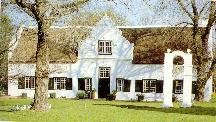Viljoen
Founding Family

The homestead of the
farm Ida's Valley, Stellenbosch, originally the farm of the progenitors
of the Viljoens. The present homestead is in the Cape Dutch architectural
style and was erected by Samuel Cats in 1787.
For a larger picture, click
on image above.
 The
Viljoen Progenitors The
Viljoen Progenitors
Francois Villion arrived
in 1671 at the Cape of Good Hope as a Huguenot refugee, who came
from Clermont, France. His occupation is first given as that of
"free wagonmaker", and later "Free Burgher" (free farmer).
He was married in Cape Town on 1676.05.17 to Cornelia Campenaar,
a young girl from Middelburg, Netherlands. In 1682 they received
the farm Ida's Valley near Stellenbosch from Governor
Simon van der Stel, where Francois Villion farmed until his death in
1689. The surname was initally spelled Villion (also Villon), and
was later changed to the present spelling of Viljoen.
It is not quite certain from
which town of Clermont Francois Villion originated, since there
are a few towns in France with this name. The best known Clermont is situated
60 km north of Paris in the province Ile de France, and it is generally
regarded to be his town of origin. All the Protestant church records were
destroyed during the persecution of the Huguenots after revoking the Edict
of Nantes in 1685, and therefore no baptismal records are available
to confirm the facts.
Francois Villion fled France
even before the Edict of Nantes was revoked in 1685, and which resulted
in the large scale persecution of the Huguenots. Their persecution already
increased in intensity as early as 1610, and large numbers had to flee
from France for their lives even before the Edict of Nantes was revoked.

Signature of Francois
Villion.
Francois Villion was in fact
the first Huguenot who settled at the Cape of Good Hope permanently. (Maria
de la Quellerie, the wife of Jan van Riebeeck who founded the
Dutch settlement at the Cape of Good Hope in 1652, was also a Huguenot,
but she left with her husband and family in 1662). Other early Huguenot
arrivals (i.e. before the organised large scale immigration of 1688 - 1689)
were the brothers François and Guillaume du Toit in
1685).
The large scale persecution
of the Huguenots started in 1685, as a result of which some 180 fled to
the Cape of Good Hope in 1688/89. Larger numbers emigrated to England,
America, Germany, Switzerland, etc.
Francois Villion went to
the Cape of Good Hope via the Netherlands in 1671. It is believed that
he met his future wife, Cornelia Campenaar, whilst waiting for a passage
in Middelburg, Netherlands, which was a harbour city at that time. She
followed him to Cape Town five years later, where they were married in
1676.
Six children were born from
their marriage, four in Cape Town and two on the family farm Ida's Valley
near Stellenbosch. Two sons, namely Henning and Johannes Viljoen,
propagated the Viljoen surname. When the progenitor died in 1689, his widow
Cornelia was left behind with six children (of ages 12, 11, 7, 5, 3 and
1 year old respectively). The youngest, Francina, was named after
her father (who probably passed away even before her birth). As a widow
Cornelia remarried Wemmer Pasman on 1690.04.14, with whom she had
three more children.

Next: The
First Viljoen Generations:
 Home
page. Home
page.
|

